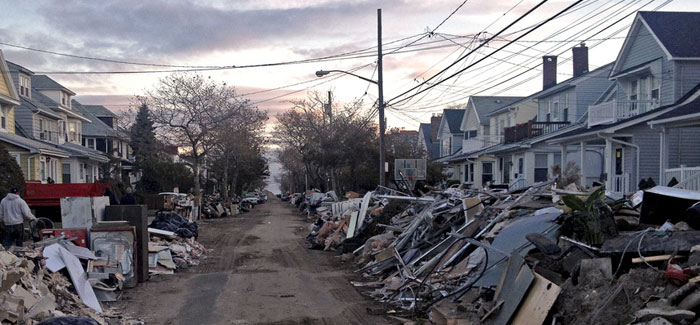
Climate change intensifies the threat to populated coastal areas from storms like Hurricane Sandy. (Photography by Anique Halliday, CC BY-NC-ND 2.0)
The social and economic threat of climate change on coastal areas, experts say, demands fast action.
Thirteen years into the 21st century, the earth’s population continues to migrate toward oceanic coasts. The timing, according to three experts at a Center for International Studies panel in January, could not be worse.
Ben Strauss, chief operating officer and director of the program on sea level rise at Climate Central, was the first to outline causes for concern during a program at the Shedd Aquarium, “Social and Biological Impacts of Rising Seas and Reduced Lake Levels.” Strauss cited Hurricane Sandy’s destruction as an example of how the effects of climate change have contributed to endangering populated coastal areas.
Since 1880, the water level in the Atlantic Ocean abutting New York City has risen 15 inches. More than half that total, Strauss said, is attributable to climate change: “Every single coastal flood which happens today is roughly eight inches deeper because of warming.”
The threat to individual coastal areas has not grown in equal proportion, Strauss explained, because each area’s topography dictates its particular vulnerability. On the US Gulf Coast, for example, a so-called 100-year storm now takes place approximately once every 75 years instead—not a particularly drastic change. Ominously, however, Strauss predicts that in Southern California a 100-year storm will be “an annual event by the middle of the century.”
In Florida, where 2.4 million people live less than four feet above the average local high tide, porous bedrock limits options to hold back water. “People are going to see water getting places where they never saw it get before,” said Strauss. “That means trouble.”
Panelist Anthony Oliver-Smith, an anthropologist and professor emeritus at the University of Florida, focused on the potentially enormous social costs of climate change. “Displacement,” Oliver-Smith said, “shreds a social group.”
He noted that there is a distinction between coastal dwellers who are merely exposed to flooding and erosion and those who are acutely vulnerable to such effects. Vulnerability depends on many factors, including wealth, but also a complex web of social and emotional circumstances not necessarily linked to income. Some costs of displacement associated with losing a home, a community, a livelihood, cannot be calculated. “Where will they go?” Oliver-Smith said. “What will they do when they get there? These are questions we really haven’t begun to answer.”
In contrast to rising sea levels, Shedd senior research biologist Phil Willink explained that climate change is causing the Great Lakes—Michigan and Huron, in particular—to recede. Lake levels have always fluctuated, Willink said, but never to such depths. His analysis was confirmed in February when the US Army Corps of Engineers announced that after a decade of diminished rain and snowfall and higher temperatures that increase evaporation, Lakes Michigan and Huron were at their lowest levels since measurements began in 1918.
These changes can no longer be ignored, the panelists agreed. Nations like China, Strauss noted, are already ahead of the curve on mitigation and adaptation to climate change, working harder than the United States, for example, on solar and wind energy.
The panelists focused less on suggesting solutions, which can be exceedingly complex from a policy standpoint, than on outlining the challenges confronting engineers, economists, and legislators. Oliver-Smith, who was most concerned about the social challenges, considers it paramount to intercede while the vulnerable can still weigh their own responses.
“If people understand what is taking place and they feel that they have a degree of control over what’s going to happen,” he said, “the resistance to change diminishes.”
